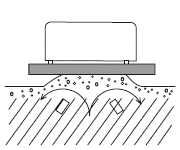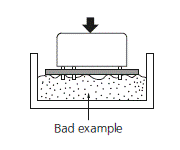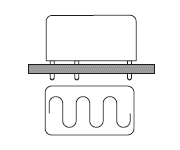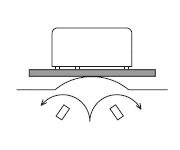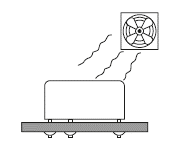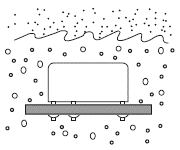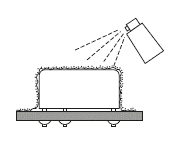When relays are welded, their functionality may be affected due to seepage of flux into the relay.
Therefore,the following precautions are provided for soldering a relay onto a PC board.
Please refer to them during installation in order to avoid problems.
The protective measures used will determine suitability for automatic soldering or automatic cleaning. Please follow the recommendations listed in "Configuration and Construction" section.
1. Mounting of Relay
- Avoid bending the terminals to make the relay self-clinching. Relay performance cannot be guaranteed if the terminals are bent.
Self-clinching terminal types are available depending on the type of relay.
- Correctly drill the PC board according to the given PC board pattern illustration.
- Stick packaging is also available for automatic mounting, depending on the type of relay. (Be sure that the relays don't rattle.)
Interference may occur internally if the gripping force of the tab of the surface mounting machine is too great. This could impair relay performance.
Return to top
2. Flux Application
- Adjust the position of the PC board so that flux does not overflow onto the top of it. This must be observed especially for dust-cover type relays.
- Use rosin-based non-corrosive flux.
- If the PC board is pressed down into a flux-soaked sponge as shown on the right, the flux can easily penetrate a dust-cover type relay. Never use this method.
- Note that if the PC board is pressed down hard enough, flux may even penetrate a flux-resistant type relay.
Return to top
3. Preheating
- Be sure to preheat before using automatic soldering. For dust-cover type relays and flux-resistant type relays, preheating acts to prevent the penetration of flux into the relay when soldering. Solderability also improves.
- Preheat according to the following conditions
| Temperature |
120°C or less |
| Time |
Within 120 seconds |
- Note that long exposure to high temperatures (e.g. due to a malfunctioning unit) may affect relay characteristics.
Return to top
4. Soldering
Automatic Soldering
- Flow solder is the optimum method for soldering.
- Adjust the level of solder so that it does not overflow onto the top of the PC board.
- Unless otherwise specified, solder under the following conditions depending on the type of relay.
| Solder Temperature |
260±5°C |
| Soldering Time |
Within 6 seconds |
- Please take caution with multilayer boards. Relay performance may degrade due to the high thermal capacity of these boards.
Hand Soldering
- Keep the tip of the soldering iron clean.
| Soldering Iron |
30 to 60 W |
| Iron Tip Temperature |
350°C |
| Soldering Time |
Within approx. 3 seconds |
| Notes |
1: |
The thermal stress on the relay may change depending on the board and process conditions. Be sure to check the actual board. |
|
2: |
Crawlability, wettability, and solder strength vary depending on the mounting conditions and the type of solder. Please evaluate under actual production conditions. |
Return to top
5. Cooling
Automatic Soldering
- Immediate air cooling is recommend to prevent deterioration of the relay and surrounding parts due of soldering heat.
- Although the environmentally sealed type relay (plastic sealed type, etc.) can be cleaned, avoid immersing the relay into cold liquid (such as cleaning solvent) immediately after soldering.
Doing so may deteriorate the sealing performance.
Return to top
6. Cleaning
- Do not clean dust-cover type relays and flux-resistant type relays by immersion.
Even if only the bottom surface of the PC board is cleaned (e.g. with a brush), careless cleaning may cause cleaning solvent to penetrate the relay.
- Plastic sealed type relays can be cleaned by immersion. Use a Freon- or alcohol-based cleaning solvent. Use of other cleaning solvents (e.g. Trichlene, chloroethene, thinner, benzyl alcohol, gasoline) may damage the relay case.
- Cleaning with the boiling method is recommended. Avoid ultrasonic cleaning on relays. Use of ultrasonic cleaning may cause breaks in the coil or slight sticking of the contacts due to the ultrasonic energy.
- Do not cut the terminals. When terminals are cut, breaking of coil wire and slight sticking of the contacts may occur due to vibration of the cutter.
Return to top
7. Coating
- If the PC board is to be coated to prevent the insulation of the PC board from deteriorating due to corrosive gases and high temperatures, note the following.
- Do not coat dust-cover type relays and flux-resistant type relays, since the coating material may penetrate the relay and cause contact failure. Or, mount the relay after coating.
- Depending on the type, some coating materials may have an adverse affect on relays. Furthermore, solvents (e.g. xylene, toluene, MEK, I.P.A.) may damage the case or chemically dissolve the epoxy and break the seal.
Select coating materials carefully.
| Type |
Suitability for Relays |
Features |
| Epoxy-base |
Good |
・Good electrical insulation
・Although slightly difficult to apply, does not affect relay contacts. |
| Urethane-base |
Care |
・Good electrical insulation, easy to apply.
・Solvent may damage case. Check before use. |
| Silicon-base |
No Good |
・Silicon gas becomes the cause of contact failure. Do not use the silicon-base type. |
- If the relay and all components (e.g. ICs) are to be coated, be sure to carefully check the flexibility of the coating material. The solder may peel off from thermal stress.
Return to top
 Business
> Industrial Devices
> Automation Controls Top
> Components & Devices
> Relays / Couplers
> Relay Soldering and Cleaning Guidelines
Business
> Industrial Devices
> Automation Controls Top
> Components & Devices
> Relays / Couplers
> Relay Soldering and Cleaning Guidelines













